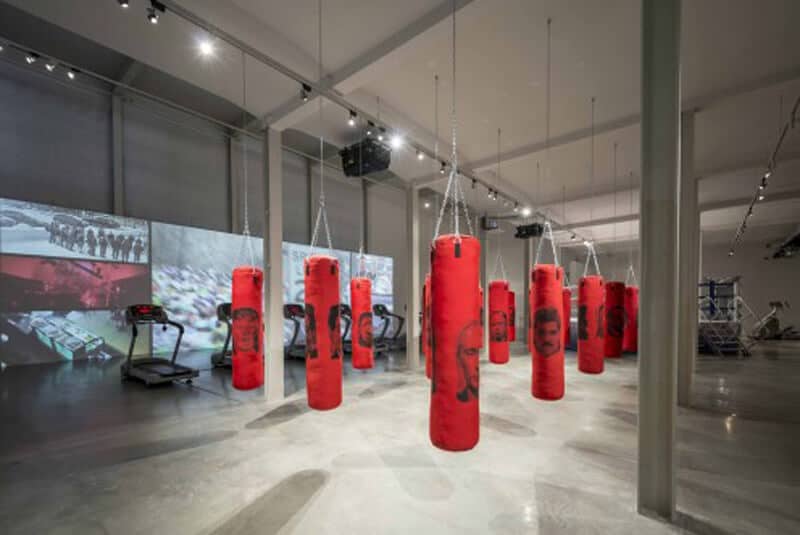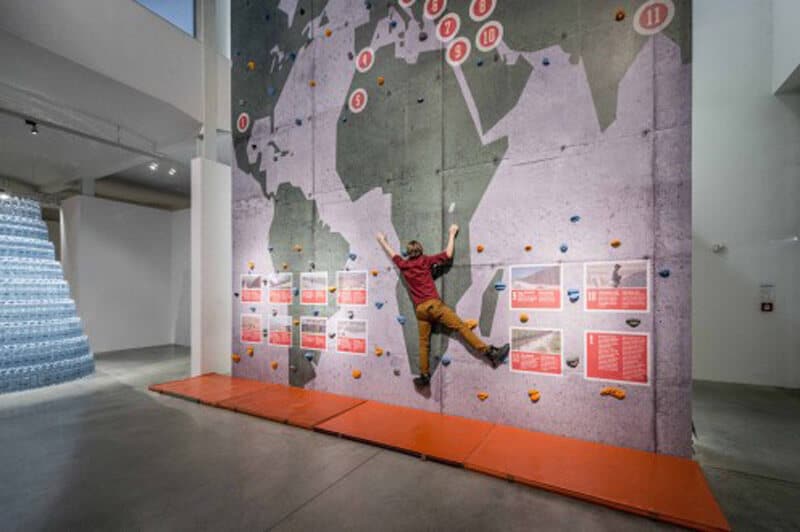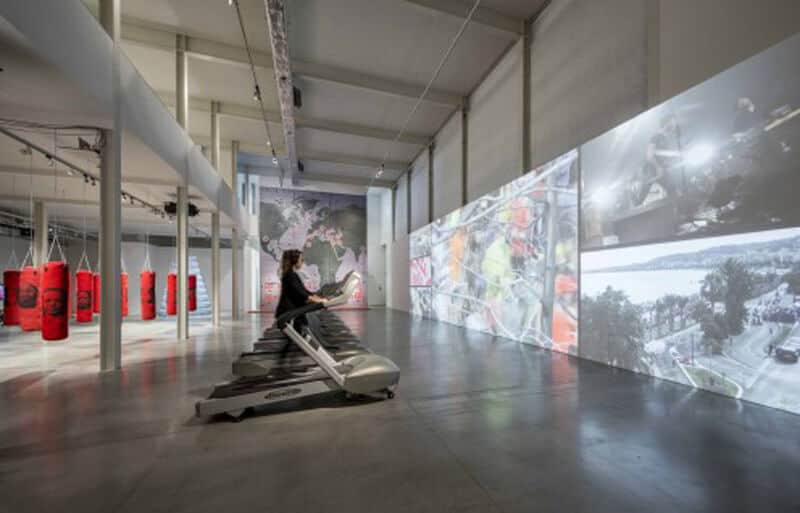Výstava WELCOME TO HARD TIMES from DOX Centre for Contemporary Art on Vimeo. It is always easier to lead your ordinary life, or as the French say “métro, boulot, dodo”, […]
Výstava WELCOME TO HARD TIMES from DOX Centre for Contemporary Art on Vimeo.
It is always easier to lead your ordinary life, or as the French say “métro, boulot, dodo”, rather than being indifferent and not afraid to express your opinion, isn’t it? After visiting the Welcome to Hard Times exhibition at the DOX gallery in Prague, you will not have a chance to stay indifferent anymore. Under the leadership of the Dutch designer and photographer Erik Kessels, 600 square meters of the exhibition hall turned into a huge gym, where a conversation with a visitor is held on urgent topics – migration, terrorism, ideological and religious confrontations and misinformation in the media – in a humorous form. Having come there, you yourself become part of the installation.
There is always a story behind everything. What is your story behind this exhibition?
I was already a little bit busy with this kind of work. Last year I did an exhibition called Jump Trump, which was like a large mat of several square meters with the portrait on, and people could really climb on a height and junp onto his face. so I think that in installations or in exhibitions there’s not a lot of reactions to what’s will going on, so I decided to change it. There was also an exhibition before called Welcome to capitalism! (in the DOX also), so then came the idea to call the new one Hard Times, and finally I had an idea to call it Welcome to Hard Times. Just to make a gym out of it and to combine these art things with wealth problems. In fact when you have a large space like this one in the DOX gallery, you can really rebuild it into a gym, and really to come here not only for physical workout, but for mental workout.
Which one of the problems you’ve pointed out you consider as the sharpest corner? Maybe there are also some, which are fake?
There is no fake one here. The fact is that there’s a growing distance in cooperation between the countries, and the politicians, and the public. It’s more and more separating and going the other way from each other and this exhibition tries to close this gap a little bit by confronting them and also helping to work people out on it.

While presenting installation you mentioned public apathy as well. Which is the reason for it?
I think, lots of it has to do with the media, they massaged us, it’s all about how quickly everything becomes normal, and also about how media has injected fear into us. In that way it’s kind bizarre, that people are more and more busy with the physical workout than with protesting or talking out loud.
Do you consider your exhibition as a piece of contemporary art or it’s just an expression of your own mind and inner thoughts?
That is a good question, because I think even in the modern art world everything needs to be framed, you know. Like – this is a sculpture, this is a painting, this is an artist… I mean for me this is just an installation.
It is also a museum, a gym, so you can call it whatever you like. It could be many things, but the purpose is clear – to provoke the public by saying: «Listen, if you go to a gym, you don’t have to say so much to each other, there are no questions in a gym, there’s just a workout. But maybe here you will have questions after you leave, won’t you?»
Do you think that you are influenced by media also? To which extent?
Of course. We get more and more influenced in that sence, there is no escape anymore – in order to do this maybe you should live in the countryside and have no television, but! – but we are now bombarded with information. People are becoming pieces of editors. Every morning you have to decide what to see, what to read, what to hear, what to listen to, and you have to make selections with that, otherwise you get crazy. But even apart from that, whatever you see, whatever you look at, there’s a repetition of it next day, because your news feeds get pumping with it. It works in a simply way: if you saw some stuff they think you’ll also want to see it next day, which is probably not true at all. We are getting more and more infected by that. On the one hand, there is not so much wrong with that, but on the other hand, people that have all the power, they totally benefit from it. You know, if you look at situation in America and how everybody there just does this. People are getting tired of all these random decisions by Trump. It’s a bizarre moment in time when this can happen. Just look at it: something happens, but if you can’t prove it on 100 percent, then it’s not true.
So how to find the truth? When you are a media specialist you have a chance to compare facts, to find out interconnections and to detect the real version. But if you are not, what then?
There is no answer to that. Well, maybe the answer is that we are far from this to see anyway, because the moral of many people is faded in a certain way. Maybe we go to gym to forget it? Getting back to the exhibition – it’s a mix of roles we are playing. It’s a boiling thing. An exhibition like this is much more difficult to do because it’s a provocation. It’s not comforting. It’s disturbing.
About disturbing – how do you fight with negative emotions in daily life?
I have still my creativity, so I can create things which are a little bit like plast on the wound of negativity, so that is maybe what I do, but I have to say it becomes more and more difficult. I think it is the same for a lot of people. There’s so much negativism and inequality in our life that you just need to look for positive things, just to balance it.

Photography is one of such balancing things for you?
Exactly. And also humor – you need that, you have to work with that. There is enough serious things going on around us. But I live on that feeling that I can create some positive things even from negative. This exhibition – it’s not heavy, it is more about light and irony anyway and that is quite nice about it.
There are several unique projects presented on the Welcome to Hard Times exhibition: multimedia project by artist Elinor Milchan from Izrael, interactive installation of Cuban-American artist Antuan Rodriguez (curated by Marisa Caichiolo) and sculpture collection created by Slovak artist Viktor Frešo.
The exhibition in the DOX gallery will run until February 4, 2019.
Author: Nina Johnson
Photos: zdroj Dox
Support us!
All your donations will be used to pay the magazine’s journalists and to support the ongoing costs of maintaining the site.
Share this post
Interested in co-operating with us?
We are open to co-operation from writers and businesses alike. You can reach us on our email at [email protected]/[email protected] and we will get back to you as quick as we can.









